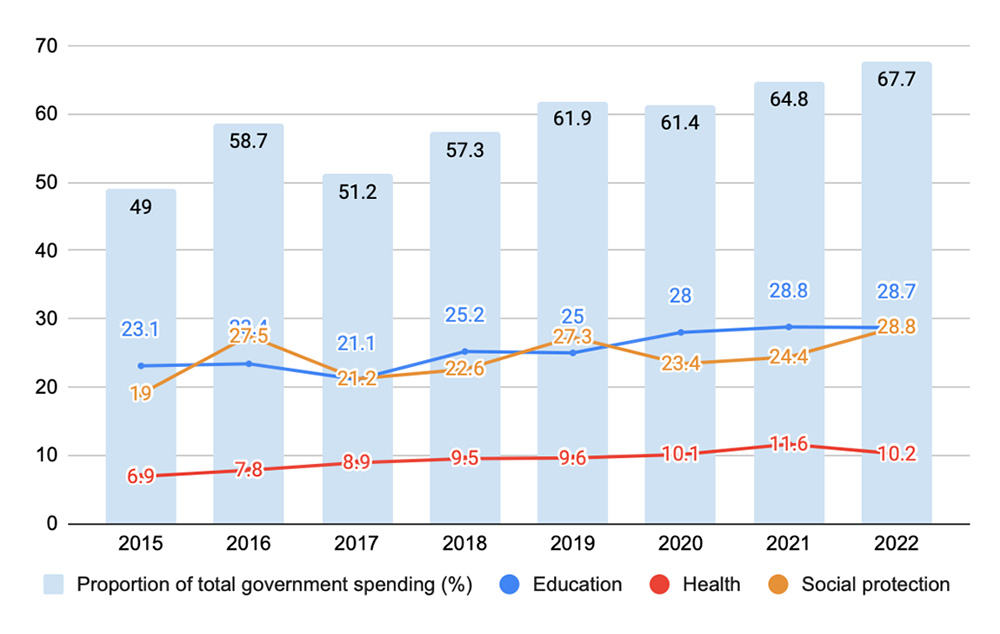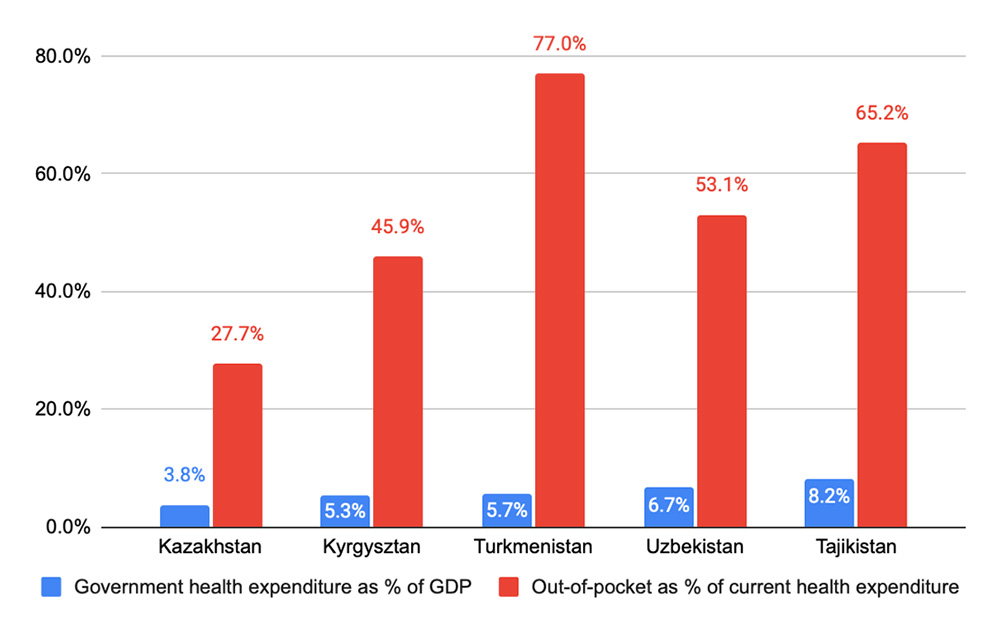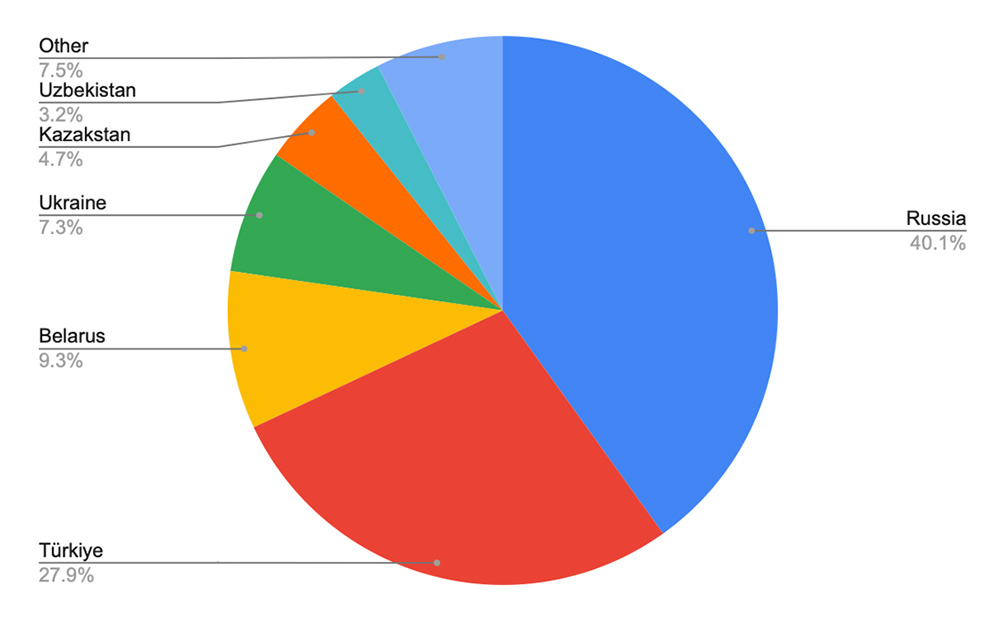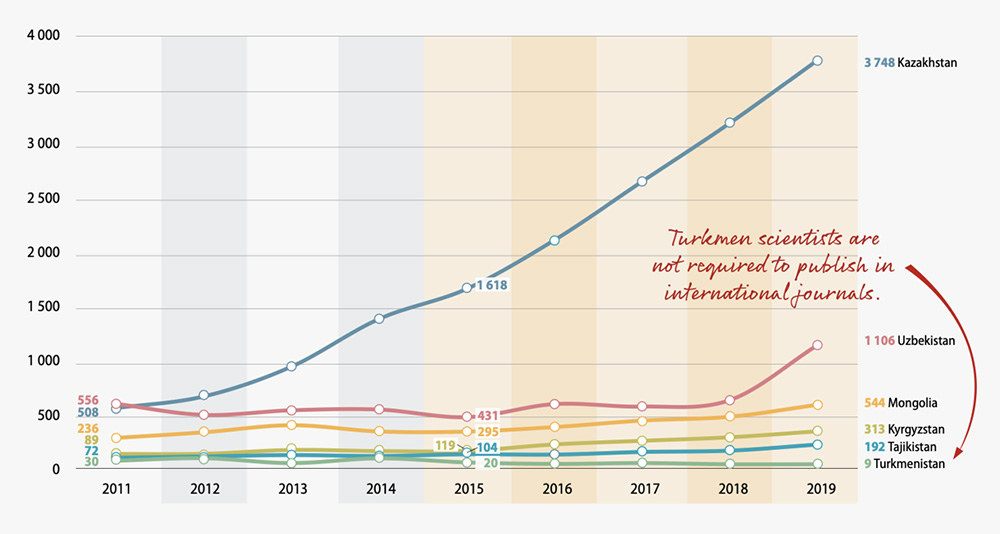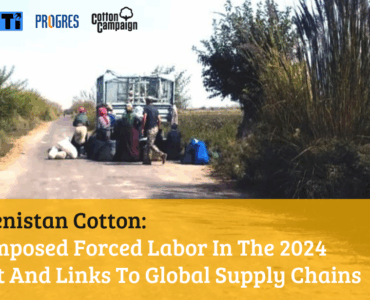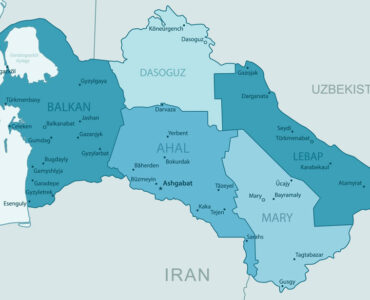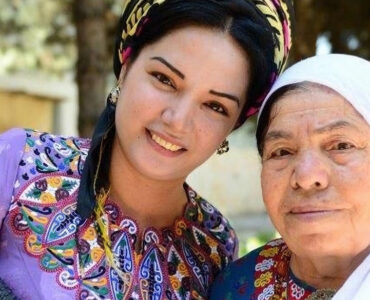This is the second article in a series examining human development in Turkmenistan. The first article assessed the level of human development while the next articles focus on complementary metrics that examine inequality and gender gaps in the distribution of human development.
Summary: The government spending in Turkmenistan is not sufficient to improve education and health outcomes for Turkmen people. Citizens in Turkmenistan carry the burden of the financial costs associated with education and healthcare. This puts them at greater financial risk and inhibits their ability to afford essential services. Meanwhile, the lack of detailed and reliable spending data and disaggregated outcomes in education and health makes it difficult to objectively measure the impact of government spending.
Turkmenistan faces structural problems such as high poverty, deficits in the education and healthcare sectors, underdeveloped infrastructure among others, which are partly due to overreliance on natural resources wealth. Because the country has relatively easy access to cash from gas exports, the government is not incentivized to develop the country’s human capital, which would be a more sustainable way to grow the country’s economy.
This article examines government spending on health, education and research and development as prerequisites for human development. Priority of health and education in budget allocation is a political choice. And based on our findings, the government in Turkmenistan does not sufficiently prioritize these sectors. Citizens in Turkmenistan carry the bulk of the financial costs associated with healthcare and education putting them at greater financial risk and unable to afford essential services.
Data for this article was collected from the World Bank, WHO, UNDP, UNESCO, Turkmenistan’s Voluntary National Review, Global Data Lab and national media outlets such as Altyn Asyr, Salam.News and Turkmenportal.
How much does the government spend on health care and education?
Answering this question is not as easy or straightforward as it seems because national and international statistics vary significantly. For example, the state budget for 2020 was 87.8 billion manats according to Turkmenportal. The Voluntary National Review (VNR) mentions that Turkmenistan spent 61.4% of the state budget on the social sector in 2020 (see Figure 1), which is 54 billion manats. The government spent almost 3 times more on education than healthcare, which accounted for 28% of the total government spending in 2020. However, there is no detailed breakdown of how this share was allocated among different educational needs and priorities.
Figure 1. Share of social expenditures in the total amount of public expenditures in Turkmenistan, %
Source: Voluntary National Review of Turkmenistan
We can also look at external sources such as international organizations that provide their estimates of government spending in Turkmenistan. According to the World Health Organisation (WHO) Turkmenistan spent 5.7% of GDP on healthcare in 2020. When compared to its neighbors, Turkmenistan has the third largest spending on healthcare after Tajikistan and Uzbekistan (see Figure 2). While Turkmenistan spends more on healthcare than Kazakhstan (5.7% vs 3.8%), people in Turkmenistan live two years shorter than people in Kazakhstan.
Figure 2. Comparing Central Asian countries’ performance in health and education with governments’ spending in these areas
Source: World Bank, WHO, Global Data Lab and UNESCO
According to the most recent data from UNESCO Turkmenistan has spent 3.12% of GDP on education in 2019. Compared to its neighbors Turkmenistan has the second lowest spending on education after Kazakhstan. Nevertheless, adults in Kazakhstan receive, on average, 1 more year of schooling than those in Turkmenistan.
However, comparing external and official estimates is challenging given that international organizations report spending as % of GDP while the government reports it as % of total government spending. The government neither provides GDP in current prices nor the government spending as a share of GDP, making it difficult to reach comparable data. Meanwhile, even international organizations are inconsistent in their reporting. To illustrate, the World Bank reports Turkmenistan’s GDP for 2020 (current US$) as USD 45.82 billion while the IMF reports USD 53,194 billion.
For our analysis we will use the World Bank data. We will also use the Heritage Foundation’s estimate for government spending for 2020 as 11.3% of the GDP. Comparing this data with the official statistics in Figure 1 we can calculate spending on education as 3.16% of GDP which is almost the same as reported by international organizations. However, spending on health is 1.14% of GDP, which is significantly lower than 5.7% reported by the WHO. Given that the government reports spending on education (28%) three times more than on healthcare (10.1%) this may be an accurate estimate.
We can also compare these statistics across countries to highlight variations in healthcare priorities and economic capacities. To illustrate, upper middle income countries, which Turkmenistan is also part of, on average spend 4.3% of GDP on education and 6.5% on healthcare, which are significantly higher than in Turkmenistan (3.16% and 1.14%, respectively). Additionally, it is not clear if the health expenditure also includes construction of hospitals. If that is the case, then it is likely that the amounts are highly inflated given the prevalence of corruption in giving out construction contracts.
At the same time, these statistics do not provide a complete picture of efficiency, effectiveness, or outcomes of healthcare and education. Other factors, such as the structure of the healthcare and education systems, the distribution of resources, and the health and education outcomes achieved, should also be considered for a comprehensive assessment. For example, when reporting spending on education the government does not provide the breakdown of spending directed to primary, secondary or tertiary education. In 2015, for example, government spending on education was 3% of GDP with only 0.3% being spent on tertiary education. This is insignificant, given that 2 out of 3 secondary school graduates are unable to enroll in tertiary education in Turkmenistan.
Given the absence of reliable and detailed statistics including on GDP, share of government spending and spending on health and education in Turkmenistan, international organizations try to make their own estimates leading to differences in their reporting. This makes the reliability of such data highly questionable making it difficult to get a realistic picture of the current situation in the country.
Who carries the financial cost of healthcare and education in Turkmenistan?
Citizens in Turkmenistan cover the bulk of the healthcare costs. In 2020 the health expenditure per capita in Turkmenistan was $483,740 of which households paid 77% out of their pockets (OOPs) while the government only covered 17.7%. Out-of-pocket payments are costs borne directly by a patient for a healthcare product or service including for self-medication. Turkmen citizens spend more on healthcare than anyone else in Central Asia. In comparison, households in Kazakhstan only spend 27.7% on healthcare out of their pockets.
Figure 3. Comparing domestic general government health expenditure as % of GDP and out-of-pocket spending as % of current health expenditure in 2020
Source: World Health Organisation
As countries develop, the share of government spending on health increases while the share of out-of-pocket spending decreases. To illustrate, government spending accounted for nearly 38% of the total health spending and out-of-pocket accounted for less than 34% in upper-middle income countries while in high income countries it was 48% and 21%, respectively (2019). Although Turkmenistan is an upper-middle income country, it performs worse than low income countries where out-of-pocket spending is only 44%. This illustrates that prioritizing health spending is more of a policy choice than a result of the government’s fiscal capacity.
In some countries out of pocket costs also include estimations of informal payments such as bribes patients give to the healthcare provider. However, it is not clear if in the case of Turkmenistan WHO takes into account informal payments. Given the pervasiveness of corruption in Turkmenistan it is very common for patients to pay the official fee at the cashier and unofficial fee to the doctor’s pocket, which is often several times higher than the formal fees. Meanwhile, estimating these informal payments is very challenging as it is not recorded or reported.
The danger of high out-of-pocket spending is that it might drive inequity in the use of healthcare services and cause financial hardships for the most vulnerable groups. The poor do not benefit as much as the rich from the health care system because they do not seek medical care as much as higher income people. When individuals have to pay for the healthcare services themselves, it might discourage them from seeking medical assistance and preventive care leading to delayed treatment and potentially worse health outcomes. Research shows that high out of pocket health expenditure leads households to spend more on health care while disregarding other necessity goods such as education. Taking into account that Turkmen households spend 52.9% of their total expenditures on food and 32% on non-food products (which includes pharmaceuticals) they are left with minimal financial resources to afford a quality life.
Similarly, when it comes to education, many young people in Turkmenistan have to sponsor their higher education abroad. This is because the majority of youth are not able to access higher education in Turkmenistan due to limited quotas at universities and widespread corruption during the enrollment process. According to UNESCO there are 69,519 Turkmen nationals studying abroad mainly in Russia – 40.1% and Turkey – 27.9% (see Figure 4). While some of these students receive national and foreign government scholarships, the majority are self-financed. The average cost of a public university in Russia in 2021 was $1,572 per year while in Turkey it was $495 per year. This does not include expenses related to living, accommodation, transportation or school supplies. To put things in perspective, the minimum wage in Turkmenistan in 2021 was USD 33.11 and average salary in 2023 was 128 USD using the market exchange rates. There are many families who lack financial resources to sponsor their children’s education at local or international universities which reinforces intergenerational poverty and robs their children of possibility for a better future.
Figure 4. Distribution of Turkmen national studying abroad by destination country
Source: UNESCO
BTI describes the education sector in Turkmenistan as extremely critical due to low level of spending and investment in education, acute shortage of qualified teachers and science-based teaching materials, education curricula being overloaded with ideologized “social science” and insufficient spending in R&D.
Another important government spending that can impact human development is public spending on research and development (R&D). R&D is a crucial driver of economic growth as it leads to innovation, invention, and breakthroughs in education and healthcare driving benefits to citizens in Turkmenistan. R&D expenditure as a proportion of GDP was merely 0.13% in Turkmenistan in 2021 while the average in upper middle income countries was 1.56%.
Insufficient R&D spending is reflected through the limited number of scientific research produced in Turkmenistan. There were only 2 scientific publications in Turkmenistan per million inhabitants compared to 202 in Kazakhstan in 2019. This is not surprising given that there were only 159 PhD students in Turkmenistan in 2015 compared to 3603 in Kazakhstan. As research confirms, government spending on R&D is a key driver for economic performance along with available stock of human capital and country’s openness.
Figure 5. Trends in scientific publishing and patenting in Central Asia Volume of scientific publications from Central Asia, 2011–2019
Source: UNESCO Science Report 2021
However, it’s not only about how much money the government spends on health and education, but also how these funds are being managed. While the government spending on the social sector has increased overtime, it did not lead to commensurate improvement in all known indicators of development for Turkmen people. Kazakhstan is doing exceptionally well in Central Asia given that it spends the least amount of money on healthcare and education while its population enjoys relatively long life expectancy and longer years of formal education compared to its neighbors. Kazakhstan gets a higher return on its investment than Turkmenistan as it is better at minimizing the cost while maximizing the efficiency and effectiveness of its spending.
Recommendations
There is a lot to do before every citizen in Turkmenistan can enjoy quality and affordable healthcare and education to reach their full developmental potential. Turkmenistan’s development should not only focus on economic growth but also on improving living standards where people can lead long and healthy lives, have access to quality education, and have meaningful jobs where they can fulfill their potential. In particular, the government of Turkmenistan should,
- Publish accurate data on government spending – the lack of transparency and accountability from government affects trust among citizens. People should be able to follow public money flows, know how much the government collects and spends and on what areas. Since resources are limited, the government needs to make sure they are being spent responsibly taking into account the interests of both, the current and future generations.
- Improve the selection process for government officials – Turkmenistan lacks a rigorous selection process for public sector employees. Public administration is inefficient due to cronyism, a high degree of job rotation in middle and upper management, bureaucratic procedures and lack of adequate education and training of the employees. Ministries and other authorities are reluctant to take initiative and make independent decisions as it is unwelcome. Instead, public officials should be encouraged to take initiatives and the jobs should be given to the most qualified and competent candidates who think long-term and have clear plans on how to improve the overall wellbeing of citizens.
- Address the pervasive and widespread corruption in the public sector – even after taking anti-corruption measures such as the adoption of Turkmenistan’s first anti-corruption law on March 3, 2014 and the creation of an anti-corruption committee, the rampant level of corruption persisted throughout the state administration and the public sector. It is primarily due to patronage, high dependence of construction and other companies on state contracts, a bloated bureaucracy, a lack of control of public finances and an underdeveloped tax system.
- Increase public spending and accountability – given the low life expectancy and average years of schooling among adults, Turkmenistan should increase its spending on improving the quality and access to holistic healthcare and education. Investments in these areas should be managed effectively and focus on areas that can add the most value. For instance, in training highly qualified medical and teaching personnel, creating an enabling environment for them to grow as professionals and to advance in their respective fields.
- Train and retain qualified workforce – even the most generous funding and latest technology in education and healthcare sectors will not bring the desired outcome if there are no people who are capable and willing to challenge the existing conventions in order to spearhead innovation in their areas. Therefore, training and retaining personnel should be a priority for the Turkmen government. Incentives should be created, so teachers and medical staff stay in Turkmenistan instead of emigrating to Russia or Turkey.
- Increase public R&D expenditure – to achieve persistent economic growth and be internationally competitive it is crucial to spend in R&D as it can help Turkmenistan innovate, invent and achieve scientific and technological breakthroughs. The government should improve the status of researchers by introducing pay rises, competitive research grants, modern research facilities and joint research projects with peers from other countries and increased international exposure. It also should improve the investment climate for businesses through improved intellectual property protection, simplified tax regimes, and tax rebates and loans for enterprises.
Image: UNICEF


